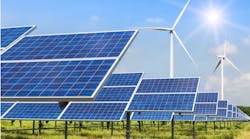Download this article in PDF format.
Derived from natural sources that are replenished at a higher rate than they are consumed, renewable energy is readily available but not always easy to harness and use. As nations around the globe work to lessen their reliance on fossil fuels like coal, oil and gas, renewable sources like sunlight, wind, water and geothermal reservoirs are all gaining in popularity.
“Generating renewable energy creates far lower emissions than burning fossil fuels,” the United Nations says. “Transitioning from fossil fuels, which currently account for the lion’s share of emissions, to renewable energy is key to addressing the climate crisis.”
An Industry that’s Ready for Takeoff
In its new 2023 renewable energy industry outlook, Deloitte credits soaring demand and attractive, long-term incentives with creating strong tailwinds for the renewable energy sector, but says it could also face some headwinds during the year ahead.
“In 2022, US renewable energy growth slackened its pace due to rising costs and project delays driven by supply chain disruption, trade policy uncertainty, inflation, increasing interest rates and interconnection delays,” Deloitte said in a press release. “Many of these challenges will likely carry over into 2023, creating strong headwinds. But growth will likely accelerate, powered by robust demand and the record-breaking raft of clean energy incentives in the Inflation Reduction Act (IRA).”
Growing demand could also exacerbate supply chain constraints and interconnection bottlenecks in 2023, according to Deloitte, which sees these issues potentially boosting prices and extending project timelines.
“Also, transmission limitations could continue to hamper growth until capacity is significantly expanded,” Deloitte adds. “However, the evolving trends and opportunities that follow could help the industry navigate headwinds as it grows in 2023 and set the stage for faster growth in 2024.”
5 Key Trends to Watch
Moving into 2023, Deloitte says some of the key factors driving the growth of the renewable energy market will include:
- Cost competitiveness. While renewable energy costs may continue to rise temporarily in 2023 due to ongoing supply chain challenges, Deloitte says wind and solar will likely remain the cheapest energy sources in most areas, as fuel costs for conventional generation have been rising faster than renewable costs.
- Federal clean energy policies. Among other supportive provisions, the IRA extends wind and solar tax credits for projects that begin construction before 2025 and technology-neutral credits through at least 2032. “Projections suggest the law will spur 525 to 550 GW of new US utility-scale clean power by 2030,” the company reports.
- State clean energy policies. Twenty-two states and the District of Columbia are targeting 100% renewable energy or 100% carbon-free electricity, Deloitte reports, often through clean and renewable energy mandates and incentives, with target dates between 2040 and 2050.
- Utility decarbonization. As of October 2022, Deloitte says 43 of the 45 largest U.S. investor-owned utilities have committed to reducing their carbon emissions, and boosting renewables is one of their key strategies for meeting those commitments.
- More investor interest. According to Deloitte, private investment in renewables hit a record high of $10 billion in the past year. “That could continue,” the company says, “as investors are attracted by transparent returns on mature technologies backed by 10-year tax credits with direct pay options.”
What’s the Outlook?
In 2023, the renewable energy industry is expected to continue growing and expanding into new areas—including offshore wind—and harnessing new opportunities opened by IRA incentives, such as clean hydrogen production and low-income area solar programs.
“And as it gains market share, [the sector is] expected to focus increasingly on managing the risks that come with that, such as cybersecurity,” Deloitte adds. “Overall, as the industry heads into 2023, soaring demand and attractive, long-term incentives are creating strong tailwinds, but there’s still a patch of turbulence to get through.”









